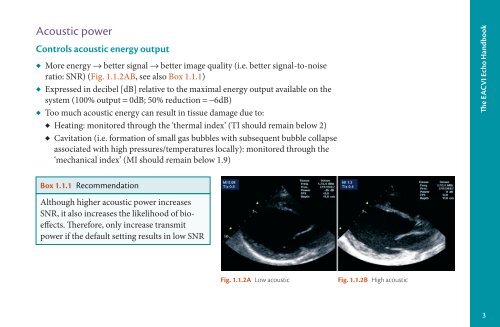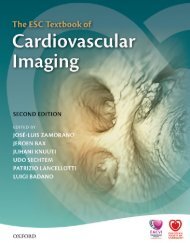EACVI Echo Handbook - sample
Discover the EACVI Echo Handbook
Discover the EACVI Echo Handbook
Create successful ePaper yourself
Turn your PDF publications into a flip-book with our unique Google optimized e-Paper software.
Acoustic power<br />
Controls acoustic energy output<br />
◆◆<br />
More energy → better signal → better image quality (i.e. better signal-to-noise<br />
ratio: SNR) (Fig. 1.1.2AB, see also Box 1.1.1)<br />
◆◆<br />
Expressed in decibel [dB] relative to the maximal energy output available on the<br />
system (100% output = 0dB; 50% reduction = −6dB)<br />
◆◆<br />
Too much acoustic energy can result in tissue damage due to:<br />
◆◆<br />
Heating: monitored through the ‘thermal index’ (TI should remain below 2)<br />
◆◆<br />
Cavitation (i.e. formation of small gas bubbles with subsequent bubble collapse<br />
associated with high pressures/temperatures locally): monitored through the<br />
‘mechanical index’ (MI should remain below 1.9)<br />
The <strong>EACVI</strong> <strong>Echo</strong> <strong>Handbook</strong><br />
Box 1.1.1 Recommendation<br />
Although higher acoustic power increases<br />
SNR, it also increases the likelihood of bioeffects.<br />
Therefore, only increase transmit<br />
power if the default setting results in low SNR<br />
Fig. 1.1.2A Low acoustic<br />
Fig. 1.1.2B High acoustic<br />
3





